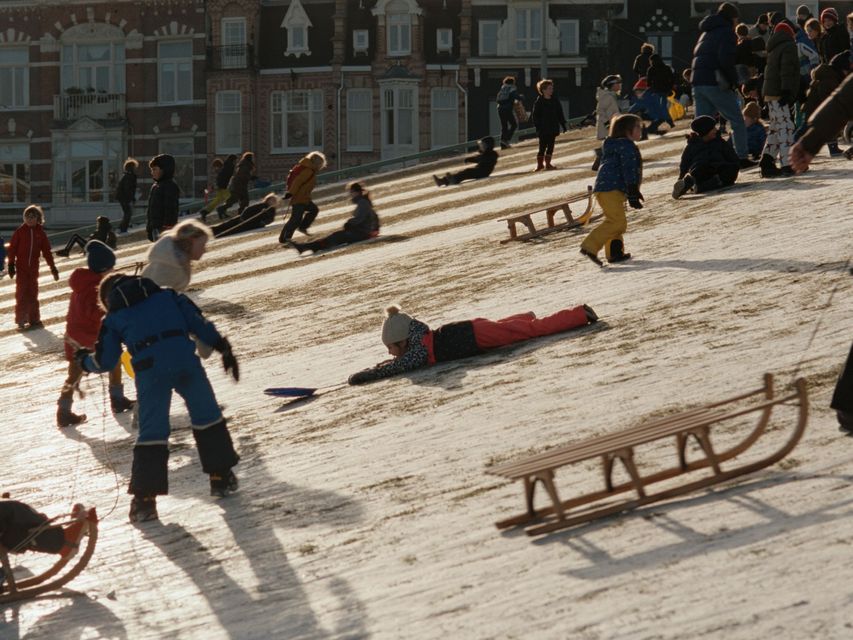Occupied City review: Austere and sprawling documentary explores the horrors of the Nazis’ occupation of Holland
Oscar winner Steve McQueen’s mesmerising four-hour film uses the prism of the present day for this intricate account
Occupied City | Official Trailer
Steve McQueen is an Oscar-winning director, best known around these parts for his Bobby Sands biopic Hunger, arguably the best film yet made about the Troubles.
Occupied City (No cert, 266mins)
But McQueen made his start in visual art, and those rarified roots are evident in this austere and sprawling documentary.
It is possible, in fact, to imagine Occupied City being shown on a continuous reel in an art gallery, with passers-by pausing momentarily to be overwhelmed by its intricate account of the Nazi occupation of Amsterdam before hurrying on.
That subject matter, combined with a four-hour-plus running length, does sound forbidding, but McQueen has found a way of making the past seem pertinent, and Occupied City makes for mesmerising viewing.
The film is based on a book by the director’s wife, Bianca Stigter, who spent 20 years researching Nazi crimes between 1940-45, and connecting them with the individual streets and buildings where they occurred.
Read more
Instead of using archive footage, however, McQueen has chosen to photograph all of these crime scenes in the present, while English actress Melanie Hyams coolly explains what happened there 80-odd years ago. The effect is unsettling.
The Wehrmacht invaded Holland on May 10, 1940, as part of their broader plans for the conquest of France. Within a week, Dutch forces had surrendered.
While there would be resistance, including a general strike by communists to protest against the treatment of Jews, there was plenty of collusion also, and more than 70pc of the Netherlands’ Jewish population were murdered during the Nazi occupation, a far higher rate than in comparable countries, like Belgium or France.
A scene from Occupied City. Photo: Modern Films
In Occupied City, meanwhile, horror is located in the most mundane places. While contemplating a boarded up shop front, we’re told that here stood one of the first cafés to put a ‘No Jews’ sign in the window.
In the city’s famous concert hall, the Royal Concertgebouw, the names of great composers adorn the upper walls: during the occupation, the Germans insisted the names of Jewish composers like Mendelssohn be covered up. This makes them sound silly, and childish, but as we know they were in deadly earnest.
A humdrum house was once the home of a 10-month-old baby, removed to a police station on account of its suspected Jewishness: a year later, the child died at Auschwitz.
The Gerrit van der Veen school was formerly the HQ of the dreaded Sicherheitspolizei, the German security police; the Hard Rock Cafe a prison yard around which people were forced to parade chanting “I am a Jew, beat me to death”.
McQueen’s film feels encyclopaedic, and almost is. He filmed every one of the 2,000-plus addresses in Bianca Stigter’s atlas, then edited down to this four-hour cut
McQueen’s film feels encyclopaedic, and almost is. He filmed every one of the 2,000-plus addresses in Bianca Stigter’s atlas, then edited down to this four-hour cut.
The film is not chronologically told, and flits back and forth in time from the two events that bookended German rule: the wave of suicides that followed the invasion, and the so-called ‘hunter winter’ of 1944-45, when the occupation ended with a crescendo of misery.
It might be easier to forget about all this, and as Steve McQueen’s crisp images of bustling modern Amsterdam suggest, the city more or less has.
But as Winston Churchill said, those who fail to learn from history are doomed to repeat it: the Holocaust happened, and no point pretending it didn’t.
The Nazis’ crimes are so endlessly numerous as to make a full comprehension of them impossible, and in a way, Occupied City proves this point, Interestingly, it makes little mention of wartime Amsterdam’s most famous wartime resident, Anne Frank, and does not visit Prinsengracht 263, site of the Anne Frank Museum, one of the city’s biggest tourist attractions.
This omission is surely deliberate, and perhaps an attempt to distance the documentary from the softening symbol of hope Anne has become, with her famous diary declaration that “in spite of everything I still believe people are really good at heart”. She died in Bergen-Belsen, probably of typhus, in the spring of 1945.
Occupied City is in selected cinemas from Friday, February 9














